The Geology of Gemstones
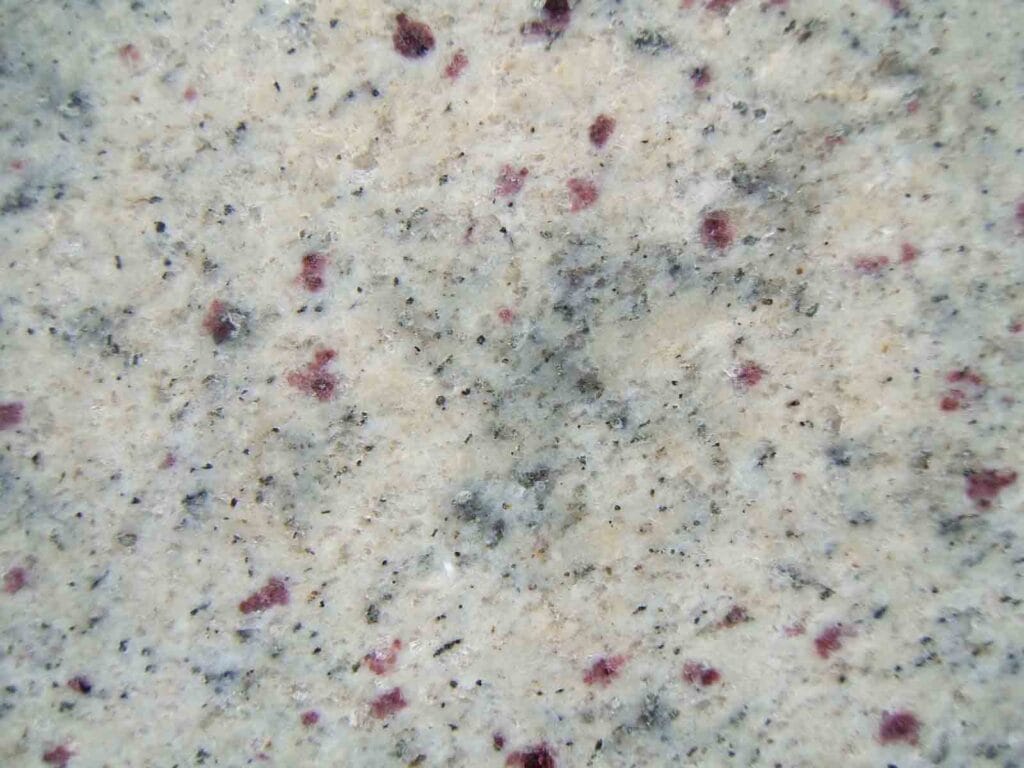
With few exceptions, accessible gem and decorative materials are formed on Earth as a result of geological processes. An understanding of these natural movements and changes can aid gemmologists in their learning and professional practice. Here, Gem-A tutor Pat Daly describes some key elements of gemstone formation, touching on chemistry, high pressures, rock types and biogenic materials.
Earth has a concentric structure. It consists of a metallic core surrounded by a rocky mantle, with an outer layer one or two hundred kilometres thick. This layer is divided into seven major and several minor lithospheric plates, which move relative to one another. The plates incorporate rocks of the outermost layer of Earth, the crust, which is of two main types. The oceanic crust is composed mostly of dark, dense rocks and seldom rises above the surface of the world’s oceans. Continental crust, which does, consists mostly of lighter-coloured, lower-density rocks.
When slowly moving (about 2 to 10 cm/year), oceanic crust moves towards continental crust; it always descends into the mantle beneath the edge of the approaching continent. It becomes hotter as it does so and begins to melt. Some of this molten material intrudes the continent and freezes to form large masses of granite. Granites, which occupy the cores of most mountain chains, consist largely of quartz and feldspar, but the original melts may have included chemical ingredients more exotic than those required for these minerals.
When the bulk of granite has solidified, a vapour-rich residue can invade fractures in the granite and the rocks around it, forming large crystals, sometimes of gem materials, containing these elements. The rocks formed in this way are called pegmatites, and they are very important gemstone sources.
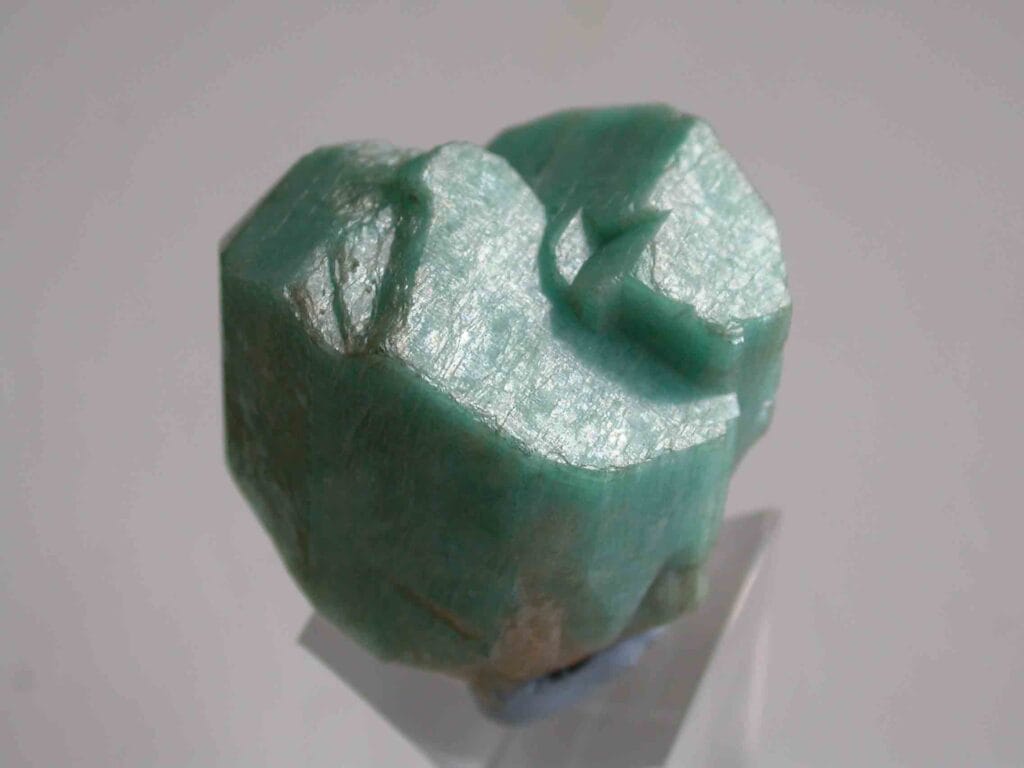 Amazonite, a type of feldspar, forms in large masses of granite. Photograph by Pat Daly.
Amazonite, a type of feldspar, forms in large masses of granite. Photograph by Pat Daly.
Rocks recrystallize at higher temperatures and pressures as they are forced down by the weight of the mountains that rise above the zone where the oceanic crust is overridden by the continent. Gems such as iolite, tanzanite and many garnets form under such conditions.
The minerals which form will depend on the chemistry of the rocks in which they grow. Beryllium, for example, which is an essential element in beryl and chrysoberyl, is present in pegmatites, but chromium, necessary for the gem varieties emerald and alexandrite, is scarce. Unusual circumstances are needed to bring these elements together. Usually, either pegmatites intrude chrome-bearing rocks, or beryllium is dissolved from them and transported by fluids to the sites where the gemstones grow.
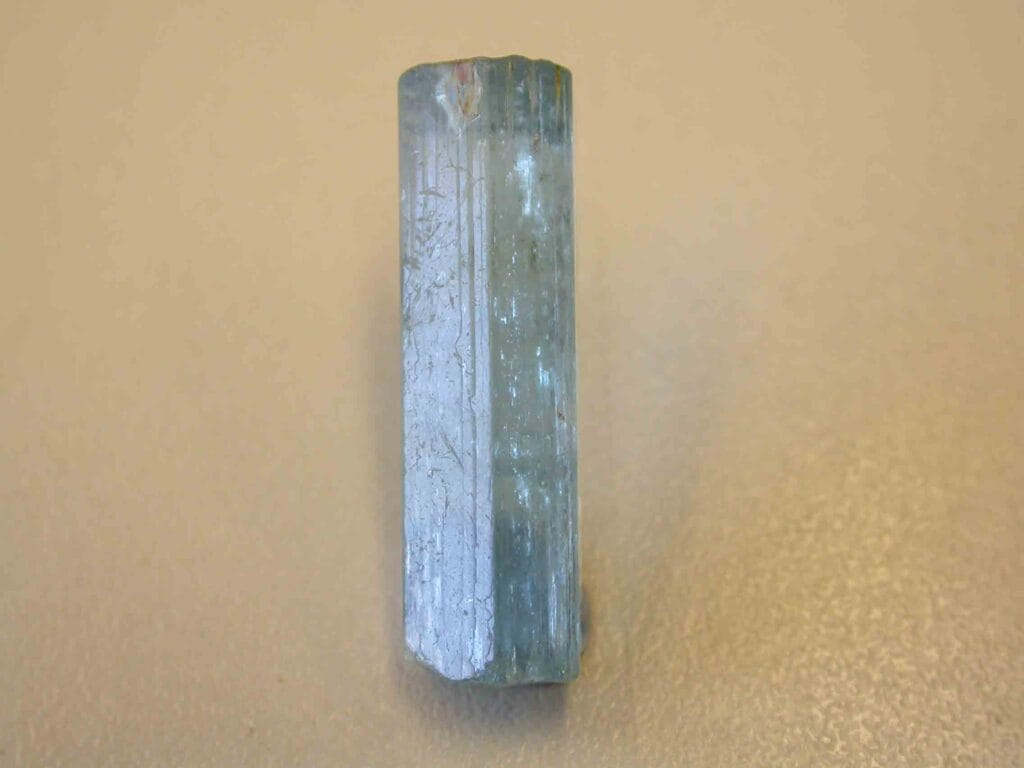 The presence of beryllium is essential for aquamarine, a variety of beryl, to form in nature. Photograph by Pat Daly.
The presence of beryllium is essential for aquamarine, a variety of beryl, to form in nature. Photograph by Pat Daly.
Most continental rocks contain a high proportion of silica, which inhibits the growth of corundum, the mineral to which ruby and sapphire belong. Silica-poor rocks such as limestones may provide an environment in which they can grow, though, again, aluminium and chromium may have to be transported to the growth site.
Jadeite requires high pressures at relatively low temperatures for its growth. In most places, both pressure and temperature increase with depth, so special conditions are needed to produce jadeite and gem-quality material is rare. Relatively cold oceanic lithosphere sinking into the mantle provides the necessary conditions, and the crystallization of jadeite results from fluids released by the descending rocks. Jadeite does not survive high temperatures and must be transported quickly to higher parts of the crust. This additional requirement for the formation of gem deposits contributes to their rarity.
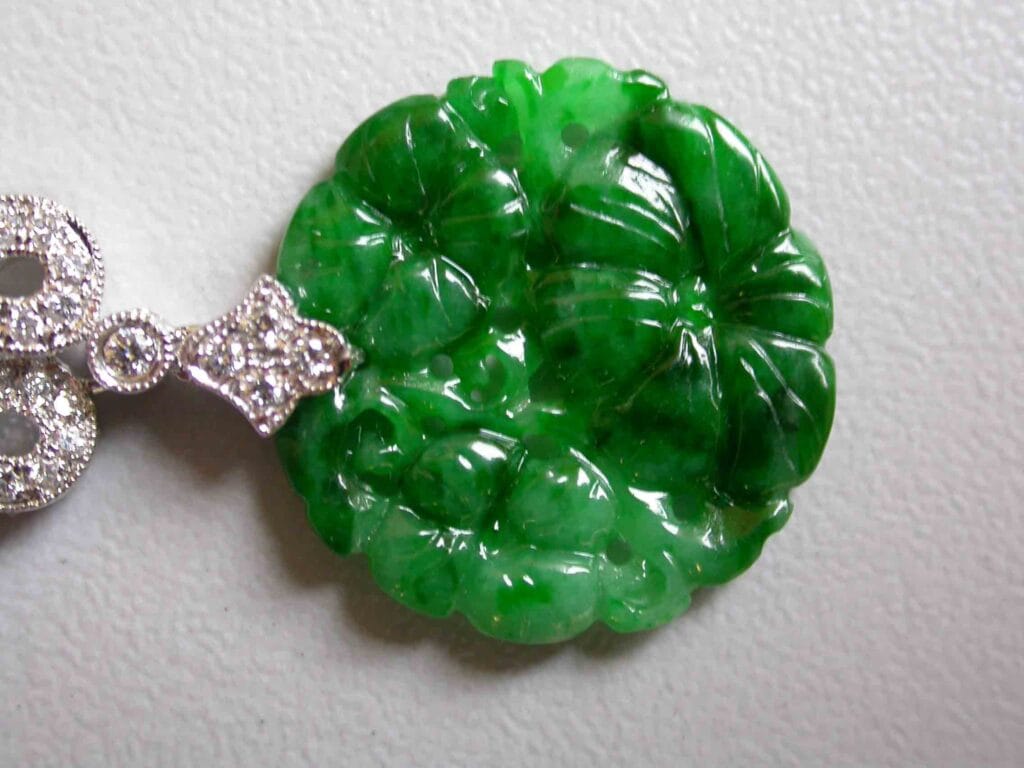 Carved jadeite photographed by Pat Daly.
Carved jadeite photographed by Pat Daly.
Diamonds also grow at temperatures which are less than typical for the depth at which the necessary high pressures are found. The right conditions occur near the bases of thickened lithospheric plates, beneath the oldest parts of continents at depths exceeding 150 km, and in the mantle below the lithosphere at still greater depths. Diamonds must also be brought to the surface quickly because a slow rise would bring them into hot regions of the crust, where they would be destroyed. Few volcanic rocks are able to transport minerals from these great depths. Most diamonds were carried by a type called kimberlite, which was named after the Kimberley mine in South Africa. These gas-rich, rapidly ascending magmas drilled and blasted their way to the surface, bringing minerals, including diamond, from the rocks through which they passed.
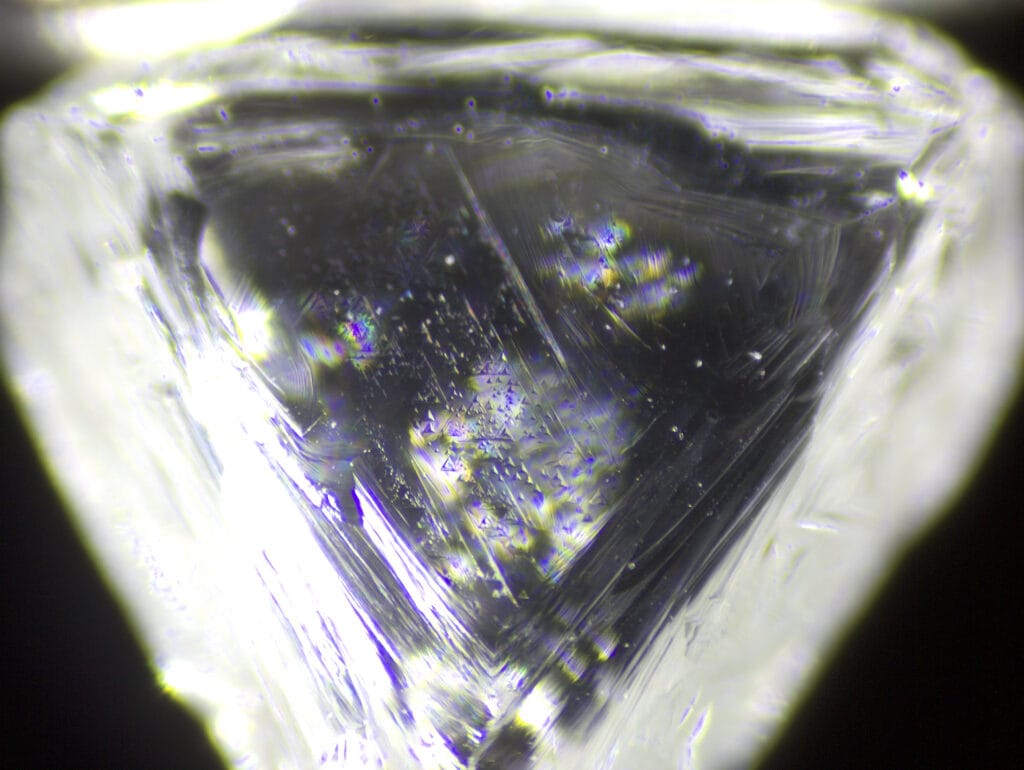 Trigons on the surface of diamond, photographed by Gabriel Kleinberg.
Trigons on the surface of diamond, photographed by Gabriel Kleinberg.
Other kinds of volcanoes bring gemstones from the mantle or deep in the crust to Earth’s surface. Important sources of peridot, ruby, sapphire and zircon result from volcanic activity.
Water circulating in the Earth’s crust becomes hotter and subject to higher pressures at greater depths, and it can dissolve materials that are not readily soluble under surface conditions. When such mineral-rich water rises to higher crustal levels, it is unable to hold so much material in solution, so the excess crystallizes in cavities and fractures in the rocks through which it moves. Many mineral deposits of industrial importance and some gem deposits are formed in this way. Fluorite, rhodochrosite, malachite and many quartz gems, for example, are formed in this way.
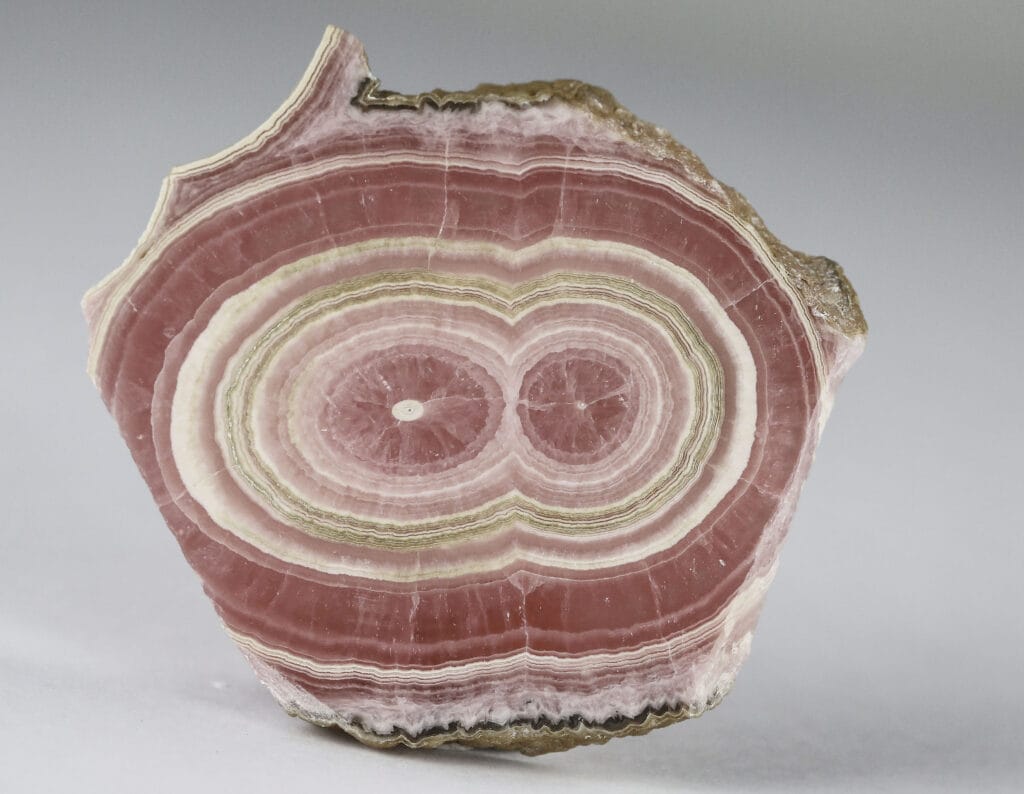 A rhodochrosite specimen, photographed by Henry Mesa.
A rhodochrosite specimen, photographed by Henry Mesa.
Holes, which were once gas bubbles in volcanic rocks, may later be filled with agate, or their walls may be lined by crystals that have grown from hydrothermal fluids. Pockets of amethyst, for example, are well-known as decorative items as well as sources of gemstones.
Gem materials grow in stable parts of continents as well as geologically active regions. Opal was deposited in sedimentary rocks laid down in an inland sea which covered a large part of the eastern half of Australia about 100 million years ago. Silica dissolved in groundwater solidified as opal when parts of the continent dried out during later geological times.
Amber originated as tree resin in forests. The largest commercial sources are in the Baltic region, especially Poland. Flooding during a marine incursion destroyed the forest, and the resin was buried, becoming amber as it matured through several million years. Jet in Europe represents pieces of fossilized wood which were washed into warm shallow seas during the Jurassic period, about 150 million years ago, and the brightly iridescent ammolite is cut from the fossilized coiled shells of animals which lived in the Cretaceous, about 70 million years ago.
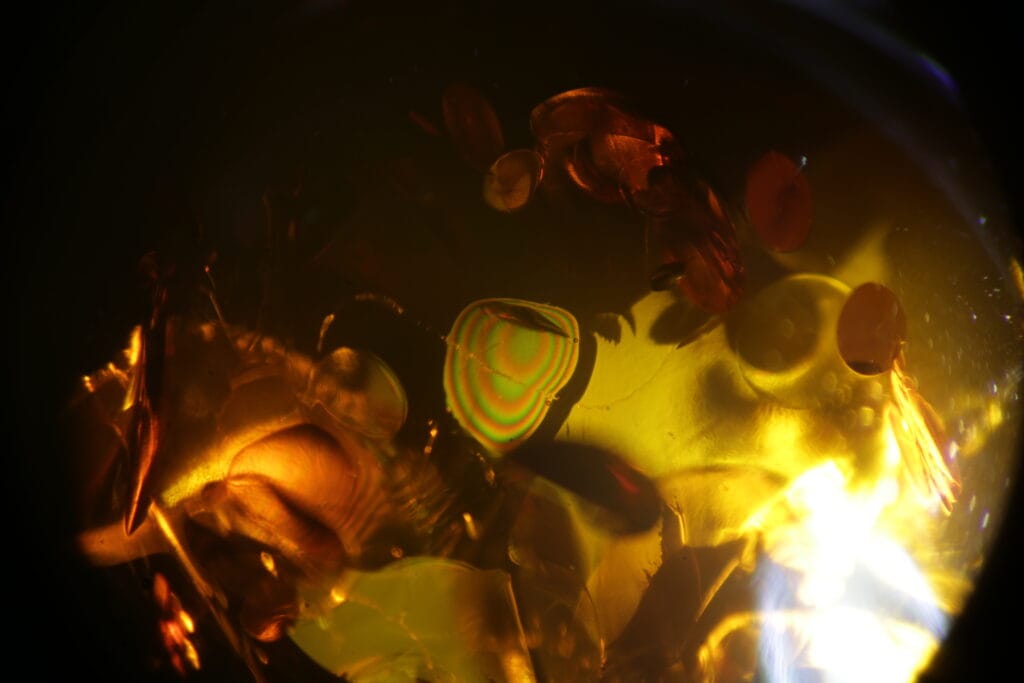
Iridescence in amber captured by Gabriel Kleinberg.
Hard rocks are broken down at the Earth’s surface, and weathering reduces them to soft masses from which gem minerals are easily released. Gems may be mined directly from these weathered rocks, as was the case in the Thai-Cambodian gem fields, which have been important sources for rubies and sapphires in recent times. More often, gemstones are washed out of the weathered rocks into rivers and, ultimately, the sea.
Gemstones in some countries, such as Sri Lanka, are recovered largely from gem-bearing gravels, and they represent important sources in most gem-producing countries. They may be more productive than the rocks in which the minerals grew or were transported because they are unconsolidated, and gems are easily separated from unwanted materials also because gem minerals tend to be concentrated in some parts of the gravels and are usually of higher average quality than those in the source rock.
Biogenic gemstones, those produced by living animals, such as shell, pearl and coral, require the appropriate conditions of water depth, temperature and salinity, and an absence of suspended silt and mud, which might hinder the growth of the creatures which grow them. These conditions cannot be taken for granted. They depend on the geological history and present activity of the regions in which they develop.
With the exception of those derived from the impact of meteorites, all gemstones have resulted from geological processes on Earth, even those which seem, at first sight, to be independent of them. The geology of gemstones is a fascinating branch of gemmology and geology, which is still being explored by scientists.
Source: The Gemmological Association of Great Britain, www.Gem-A.com. Main Image: Garnet in matrix from the Gem-A Archives.